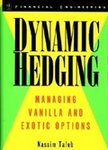- ISBN
- 0471152803
- Author
- Nassim Taleb
- Format
- Hb
- Edition
- 1st
- Published
- Jan 1, 1997
- Publisher
- John Wiley & Sons
Dynamic Hedging is the definitive source on derivative risk. It provides a real-world methodology for managing portfolios containing any nonlinear security. It presents risks from the vantage point of the option market maker and arbitrage operator. The only book about derivatives risk written by an experienced trader with theoretical training, it remolds option theory to fit the practitioner's environment. As a larger share of market exposure cannot be properly captured by mathematical models, noted option arbitrageur Nassim Taleb uniquely covers both on-model and off-model derivatives risks.
Vital issues include:
- The generalised option, which encompasses all instruments with convex payoff, including a trader's potential bonus.
- The techniques for trading exotic options, including binary, barrier, multiasset, and Asian options, as well as methods to take into account the wrinkles of actual, non-bellshaped distributions.
- Market dynamics viewed from the practitioner's vantage point, including liquidity holes, portfolio insurance, squeezes, fat tails, volatility surface, GARCH, curve evolution, static option replication, correlation instability, Pareto-Levy, regime shifts, autocorrelation of price changes, and the sever flaws in the value at risk method.
- New tools to detect risks, such as higher moment analysis, topography exposure, and nonparametric techniques.
Vital issues include:
- The generalised option, which encompasses all instruments with convex payoff, including a trader's potential bonus.
- The techniques for trading exotic options, including binary, barrier, multiasset, and Asian options, as well as methods to take into account the wrinkles of actual, non-bellshaped distributions.
- Market dynamics viewed from the practitioner's vantage point, including liquidity holes, portfolio insurance, squeezes, fat tails, volatility surface, GARCH, curve evolution, static option replication, correlation instability, Pareto-Levy, regime shifts, autocorrelation of price changes, and the sever flaws in the value at risk method.
- New tools to detect risks, such as higher moment analysis, topography exposure, and nonparametric techniques.

